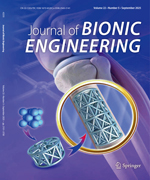|
|
Biomimetic Superhydrophobic Surfaces with Transition Metals and Their Oxides: A Review
Xiaoyu Gao, Zhiguang Guo
Journal of Bionic Engineering. 2017, 14 (3):
401-439.
DOI: 10.1016/S1672-6529(16)60408-0
Transition metals and their oxide materials have been widely employed to fabricate superhydrophobic surfaces, not only because of their surface topography with controllable microstructures leading to water-repellence, diverse adhesion even tunable wettability, but also due to a variety of special properties like optical performance, magnetism, anti-bacterial, transparency and so on. At the meantime, biomimetic superhydrophobic surfaces have attracted great interest from fabricating hierarchical micro-/nano-structures inspired by nature to imitate creature’s properties and many potential applications, including self-cleaning, antifogging, antireflection, low drag and great stability and durability. In this review, natural surfaces and biomimetic materials with special wettability are introduced by classification according to the similar microstructure of morphology, like array structure, sheet overlapped structure, high density hairs and seta shaped structure. Not only do we exhibit their special performances, but also try to find out the true reasons behind the phenomenon. Then, the recent progress of a series of superhydrophobic transition mental and their oxide materials, including TiO2, ZnO, Fe3O4, CuO, Ag, Au and so on, is presented with a focus on fabricating methods, microstructures, wettability, and other properties. As followed, these superhydrophobic surfaces can be applied in many fields, such as oil/water separation, self-cleaning, photo-controlled reversible wettability, surface-enhanced Raman scattering, antibacterial, anticorrosion, and synthesis of various applications. However, few of them have been applied in practical life. Hence, we discuss the remaining challenges at present and the development tendency in future at the end of this article. This review aims to present recent development of transition metals and their oxides applied in biomimetic superhydrophobic surfaces about fabrication, microstructure, water repellence, various properties, and potential applications.
Related Articles |
Metrics
|

 Table of Content
Table of Content
 Table of Content
Table of Content